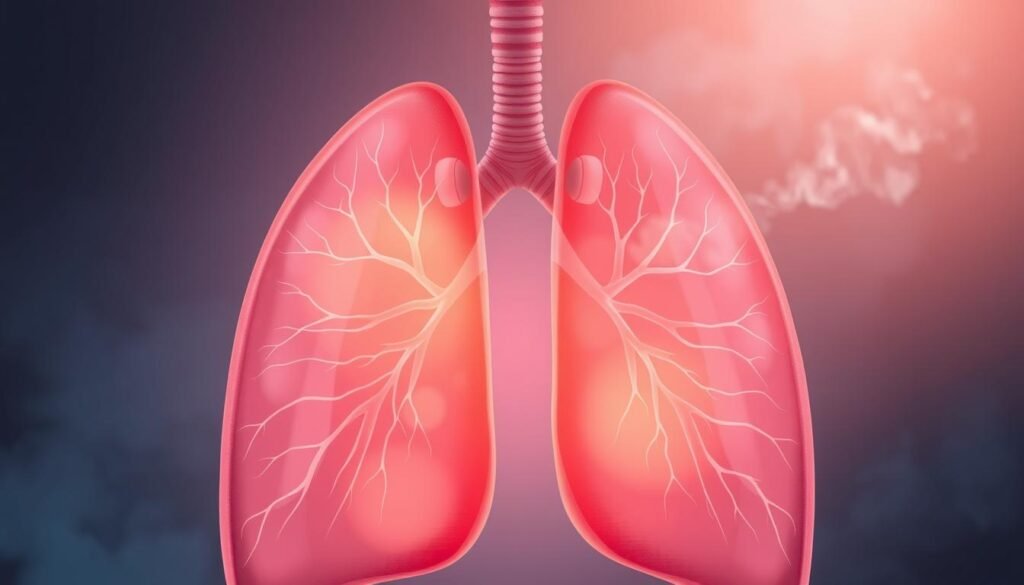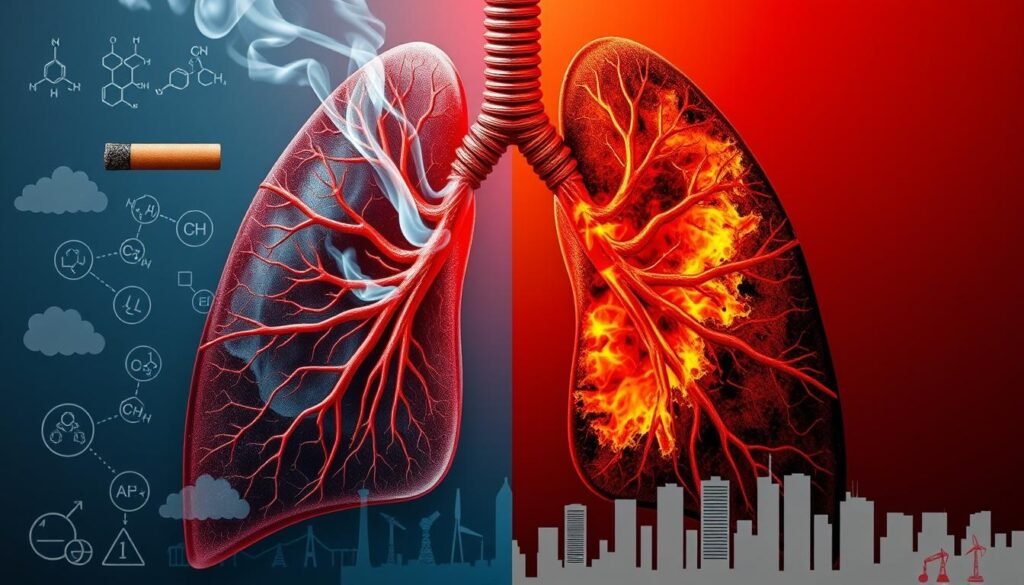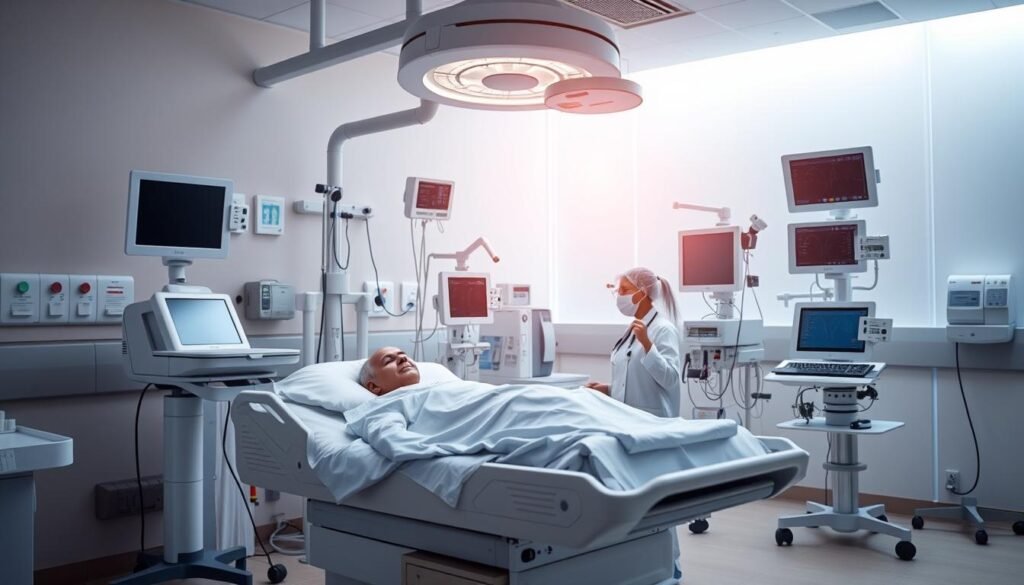Lung cancer is the top cause of cancer deaths among men and women in the US. Almost 90% of these are non-small cell lung cancer (NSCLC) cases. About 10-15% are small cell lung cancer (SCLC).
This big difference shows why it’s key to know about the different types of lung cancer. It matters for treatment and how well a patient might do.
NSCLC grows slower than SCLC and includes types like adenocarcinoma and squamous cell carcinoma. On the other hand, SCLC grows fast and spreads early. Knowing the difference helps doctors and patients act fast on symptoms.
Key Takeaways
- NSCLC makes up about 80-85% of lung cancer cases.
- SCLC is more aggressive and spreads quickly.
- NSCLC’s common kinds are adenocarcinoma, squamous cell carcinoma, and large cell carcinoma.
- Smoking causes roughly 98% of SCLC cases.
- Finding cancer early greatly increases the chances of survival for both types.
- Doctors suggest yearly checks for people at high risk.
Understanding Lung Cancer Types
Lung cancer falls into two main lung cancer types: small cell (SCLC) and non-small cell (NSCLC). Knowing the differences between these types helps with early detection and treatment.
Overview of Lung Cancer
About 85% of lung cancers are NSCLC, with the rest being SCLC. NSCLC includes lung adenocarcinoma, squamous cell lung cancer, and large cell lung cancer. Lung adenocarcinoma makes up 40% of NSCLC cases.
Many NSCLC adenocarcinomas have genetic mutations. This has led to new targeted therapies. Tests to find these mutations guide doctors in choosing the best treatments.
Differences between SCLC and NSCLC
The main SCLC vs NSCLC differences are in how they grow and spread. SCLC usually starts in the bronchi and grows fast because of its association with smoking. It quickly spreads to lymph nodes and other organs. NSCLC grows more slowly and is more common.
Understanding these differences is crucial. Symptoms like weight loss and a constant cough are early warning signs. Recognizing these early symptoms is key to getting a quick diagnosis. For more on lung cancer symptoms, visit this useful site.
What is Small Cell Lung Cancer?
Small cell lung cancer (SCLC) is a major type of lung cancer. It makes up about 15% of all cases. It’s known for quick growth and starts in the bronchi.
Knowing about SCLC is key for early diagnosis and treatment.
Characteristics of SCLC
Most people with SCLC have smoked before, over 95% in fact. It’s often found late, which makes early detection important. SCLC has two main stages:
- Limited Stage: Cancer is only on one side of the chest. About one-third of cases are like this.
- Extensive Stage: Cancer has moved to the other lung or further.
About 85% of lung cancer is found late. This makes choosing the right treatment hard. Options like chemo or radiation depend on these facts.
Types of Small Cell Lung Cancer
There are two kinds of SCLC:
- Small Cell Carcinoma: Also known as oat cell cancer, it’s the most common type.
- Combined Small Cell Carcinoma: This type has both SCLC and non-small cell traits.
Treating SCLC usually needs a combination of methods. Treatment often includes chemo with drugs like cisplatin or carboplatin plus etoposide. Knowing about certain genes, like TP53 and RB1, helps pick the right treatment. For more on lung cancer types, check out lung cancer types.
What is Non-Small Cell Lung Cancer?
Non-small cell lung cancer (NSCLC) makes up about 80 to 85 percent of lung cancer cases. It’s the main form of lung cancer. Understanding NSCLC is key for diagnosis and treatment. This cancer type usually grows slower than small cell lung cancer, leading to different treatment methods and results for patients.
Characteristics of NSCLC
NSCLC has various tumor types and behaviors. It shows different signs than small cell lung cancer. Symptoms like a constant cough, chest pain, or losing weight can appear. Finding it early can greatly improve treatment choices and the chance of survival. If the cancer is localized, the five-year survival rate is around 65%.
Common Types of Non-Small Cell Lung Cancer
The most seen types of NSCLC are:
- Adenocarcinoma: This type is most common and affects both smokers and those who’ve never smoked.
- Squamous cell carcinoma: Often linked to smoking, it usually starts in the central parts of the lungs.
- Large cell carcinoma: This is rarer but can grow fast and spread quickly.
There are other NSCLC types like adenosquamous carcinoma and sarcomatoid carcinoma. Each type has unique features and treatment needs. Knowing the different NSCLC types helps in tailoring patient care and figuring out the outlook.
Lung Cancer Symptoms
Lung cancer signs can differ a lot from one person to another. It’s important to know what to look for to catch it early. Both small cell lung cancer (SCLC) and non-small cell lung cancer (NSCLC) have similar signs. Yet, they might show different signs based on their stage and what type they are.
Common Symptoms Shared by Both Types
Here are some signs people with SCLC and NSCLC might have:
- Coughing that doesn’t go away
- Chest discomfort or pain
- Shortness of breath
- Loss of appetite or unexplained weight loss
- Fatigue that persists and affects daily activities
How often and how bad these signs are can change a lot. While both cancer types have many common signs, SCLC might also include issues from cancer spreading. This could be bone pain or problems with nerves.
Early vs. Late Stage Symptoms
Catching signs early can greatly improve outlooks. Early-stage lung cancer may not show much, making it easy to miss important health signs. But, as lung cancer grows, the signs tend to be clearer:
- Early Stage: Might not show signs, or they’re mild; some may have a slight cough or feel tired.
- Late Stage: Signs get worse, including serious pain, breathing problems, and losing weight.
Getting checked regularly is key, especially for those who smoke or have lung cancer in their family. Knowing what signs to look for helps find cancer early. This can lead to better options for treatment.

Lung Cancer Staging
Staging plays a crucial role in determining the treatment and prognosis for individuals diagnosed with lung cancer. The process varies significantly between the two primary types: Small Cell Lung Cancer (SCLC) and Non-Small Cell Lung Cancer (NSCLC).
Understanding Stages of SCLC
In SCLC staging, cancer is classified into two main categories. The limited stage refers to cancer confined to one lung and might include nearby lymph nodes. On the other hand, the extensive stage indicates a more advanced situation where cancer has spread beyond the initial lung, possibly affecting other organs or tissues.
Due to its aggressive nature, SCLC is often diagnosed at a more advanced stage, frequently stage 3 or 4. This late detection impacts treatment options significantly.
Understanding Stages of NSCLC
NSCLC staging follows a more detailed classification system, ranging from stage 0 to stage IV. Each stage corresponds to specific characteristics of tumor growth and spread:
| Stage | Description |
|---|---|
| Stage 0 | Carcinoma in situ; cancer is limited to the top lining of the lung or bronchus, with no spread. |
| Stage I | Divided into sub-stages 1A and 1B; early-stage lung cancer where the tumor is small and has not spread to lymph nodes. |
| Stage II | Further divided into IIA and IIB; tumors may be larger and have spread to nearby lymph nodes but not to distant organs. |
| Stage III | Includes IIIA, IIIB, or IIIC; common occurrence of lymph node involvement in the mediastinum region. |
| Stage IV | The most advanced stage, indicating metastasis to the lung lining or other parts of the body. |
Accurate lung cancer staging is vital. It directly influences treatment options, allowing for a tailored approach based on the specific cancer type, stage, and the overall health of the individual. Minimally invasive surgery remains a common option for those diagnosed with initial stage NSCLC. Meanwhile, newer treatments like Sotorasib are emerging for advanced stages, showcasing the importance of timely and precise staging in managing lung cancer effectively.
Lung Cancer Risk Factors
Understanding lung cancer risk factors is crucial. Smoking is the top risk factor for lung cancer. It causes 80% of lung cancer deaths. The danger is seen clearly in SCLC, where nearly all cases are in smokers.
Smoking and Environmental Factors
Smoking tobacco for a long time greatly increases lung cancer risk. Secondhand smoke is also a big problem. It’s the third main cause of lung cancer in the U.S. Environmental factors play a role too. For example, radon and asbestos exposure increase the risk, especially for non-smokers. Smoking makes it even worse.

| Risk Factor | Type of Cancer | Notes |
|---|---|---|
| Smoking | SCLC, NSCLC | Accounts for 80% of lung cancer deaths. |
| Secondhand Smoke | SCLC, NSCLC | Increases risk for non-smokers. |
| Radon | NSCLC | Second leading cause among non-smokers. |
| Asbestos Exposure | NSCLC | Workers face several times higher risk. |
| Air Pollution | NSCLC | Contributes to 1-2% of all lung cancer deaths. |
Other Risk Factors for SCLC and NSCLC
There are more risks for lung cancer besides smoking and the environment. Working with uranium and arsenic can raise the risk. Having lung cancer in your family history increases your chances. Interestingly, beta-carotene supplements may make smokers more likely to get lung cancer. E-cigarettes’ health risks are being studied. More research is needed on the link between marijuana smoke and lung cancer.
Lung Cancer Screening
Screening for lung cancer is key in battling this illness, especially for those at high risk. People who have smoked a lot over the years need to be very careful. The American Cancer Society suggests yearly low-dose CT scans for folks 55-74 who smoked a lot. Catching it early means better chances for effective treatment.
Who Should Get Screened?
Some people should really think about getting a lung cancer screening. They include:
- Aged 55 to 74
- A history of heavy smoking (one pack per day for 30 years or two packs per day for 15 years)
- Current smokers or those who quit in the last 15 years
Screening those at high risk can spot lung cancer early on. This gives patients a better shot at treatment.
Screening Methods for High-Risk Patients
There are different ways to screen for lung cancer, but the CT scan is most common. Key methods are:
| Method | Description | Effective For |
|---|---|---|
| Low-Dose CT Scan | A specialized X-ray procedure using lower radiation doses. | Detecting early-stage lung cancer in high-risk individuals. |
| X-rays | A standard imaging technique often used for initial lung evaluations. | Not as effective as CT for screening lung cancer. |
| PET Scans | Positron emission tomography detects metabolic activity in cells. | Identifying cancer spread and monitoring treatment response. |
Talking regularly with healthcare pros about lung cancer screening helps at-risk folks get checked fast and correctly.
Lung Cancer Treatment Options
Treatment choices for lung cancer depend on its type and stage. It’s vital to know the options for small cell lung cancer and non-small cell lung cancer. This helps manage the disease better.
Treatment for Small Cell Lung Cancer
Patients with small cell lung cancer often receive both chemotherapy and radiation therapy. This cancer spreads quick, so early treatment is critical.
- Chemotherapy: Aims to reduce or eliminate cancer cells.
- Radiation Therapy: Uses high-energy rays to kill cancer cells.
- Clinical Trials: Offers access to new treatments.
- Complementary Approaches: Alternative treatments, like acupuncture, are explored.
Treatment for Non-Small Cell Lung Cancer
Non-small cell lung cancer has more treatment options, especially if caught early. These treatments can include:
- Surgery: Works best for stage 0 NSCLC by removing the cancer.
- Chemotherapy: Often used with other treatments in later stages.
- Radiation Therapy: Can be a main treatment or support surgery.
- Targeted Therapy: Blocks cancer cell growth pathways.
- Neoadjuvant Therapy: Shrinks tumors before surgery, useful in stage II.
Choosing a lung cancer treatment requires advice from several specialists. Testing for genetic mutations can change how effective some treatments are, especially in advanced stages. Each plan is tailored to the patient’s health and wishes.

| Treatment Type | SCLC Treatment Options | NSCLC Treatment Options |
|---|---|---|
| Surgery | No | Yes, especially stage 0 |
| Chemotherapy | Yes | Yes |
| Radiation Therapy | Yes | Yes |
| Targeted Therapy | No | Yes |
| Clinical Trials | Yes | Yes |
Non Small Cell Lung Cancer vs Small Cell
Understanding the differences in lung cancer types is vital. Non-Small Cell Lung Cancer (NSCLC) is the most common, with about 85% of cases. Small Cell Lung Cancer (SCLC) makes up about 15%. The lung cancer prognosis for NSCLC tends to be better.
For example, the five-year survival rate for localized NSCLC can be up to 64%. This is much higher than the less than 5% often seen with late-stage SCLC.
Comparative Prognosis and Outcomes
Survivability is a key concern for both types of lung cancer. SCLC patients usually live about 7 months after diagnosis. Many have the disease spread at the point of diagnosis. On the other hand, NSCLC outcomes have improved, thanks to new treatments. This is especially true for early-stage diagnoses.
Knowing these differences helps patients and families make informed treatment choices. This knowledge is crucial for managing the disease.
Importance of Early Diagnosis
Spotting lung cancer early is critical for effective treatment. Signs to watch for include a persistent cough, chest pain, or coughing up blood. Screenings can find NSCLC and SCLC sooner, especially in high-risk groups. Talking about symptoms early can save lives. Being aware of the first signs is key.
Conclusion
It’s important to know about lung cancer. This helps tell apart non-small cell lung cancer (NSCLC) from small cell lung cancer (SCLC). Knowing their characteristics, risk factors, symptoms, treatments, and outcomes helps in making informed choices.
Lung cancer is a top cause of cancer deaths in the U.S. Predictions for 2024 show about 234,580 new cases and 125,070 deaths. This shows why understanding lung cancer deeply matters.
Being aware of lung cancer is critical, especially since smoking greatly increases risk. Smokers are ten times more likely to get lung cancer than non-smokers. Even those who quit smoking still face higher risks for years. Talking with healthcare providers about lung health can lead to early screening and better outcomes.
Knowing the signs of lung cancer is key since early detection can save lives. Screening high-risk patients with low-dose helical CT scans has shown to reduce the death rate. For detailed info on lung cancer, including how genetic testing shapes treatment, check out this analysis. Education on lung cancer is growing, leading to higher awareness and healthier lives.